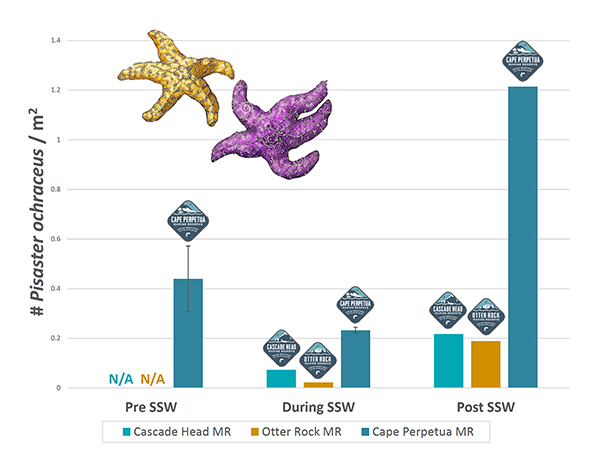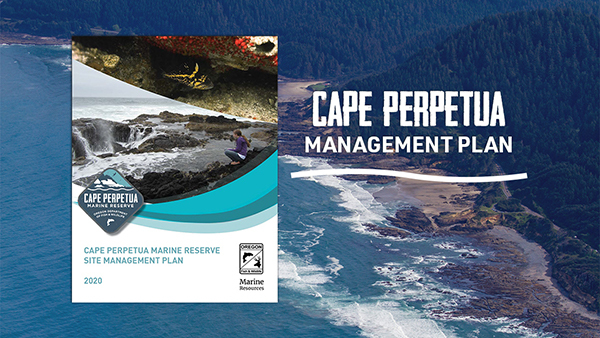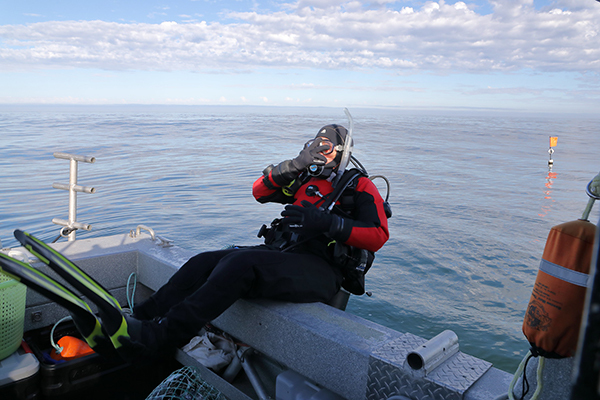Podcast: A Plunge Underwater Into
Oregon’s Marine Reserves
Our past OSU-ODFW Science Integration Fellow, Ashley Knight, was recently featured in a podcast produced by Meet the Ocean. Join Ashley in this 10 minute podcast as she shares some of her underwater SCUBA adventures and explores what lies beneath the surface at Oregon’s marine reserve sites. Listen as she describes descending into frigid and murky waters, battling strong underwater surges, encountering big schools of Black Rockfish, and piloting an underwater stereo video camera system. All making for good science and great stories.
You can also check out the ODFW Information Report authored by Ashley during her Fellowship: A stereo video system for monitoring Oregon’s Marine Reserves
 
Exploring Intertidal Data:
Before, During, and After Sea Star Wasting
 Summertime means intertidal monitoring season for the ODFW Marine Reserves Program. When tides are at their lowest from June to August, we venture into the intertidal zone to survey sea stars and their habitats as part of multiple long-term intertidal monitoring studies in Oregon.
Sea stars are the dominant predator in rocky intertidal habitats, keeping mussels in check and providing habitat for lots of invertebrates and algae. Unfortunately, they were nearly wiped out by sea star wasting disease (SSW) a few years back. Our biodiversity surveys track changes in the intertidal community, including sea stars, and are conducted every few years at three marine reserve sites that have accessible intertidal habitat (Cascade Head, Otter Rock and Cape Perpetua).
 Results from these intertidal surveys indicate that while Ochre Sea Star (Pisaster ochraceus; the dominant sea star) densities declined during the SSW outbreak, they are rebounding nicely at all three marine reserve sites. The increasing densities indicate that these sea stars are on the mend, which is a huge relief, as many sea star populations have not recovered in many areas of California.
Note: Sea star surveys began at Otter Rock and Cascade Head in 2015, so no pre-sea star wasting data are available from these sites. Sea star data extracted from the ODFW-MARINe intertidal biodiversity surveys.
Cape Perpetua Management Plan

The Cape Perpetua Management Plan is now available. The Plan outlines the state’s marine reserve mandates and describes the management, outreach, and engagement strategies that have been developed for the Cape Perpetua Marine Reserve. These strategies were developed with help and input from local community members and other interested Oregonians.
You can use site management plans, developed for each of Oregon’s reserves, to:
- Understand the state’s mandates guiding implementation of Oregon’s marine reserves and the ODFW Marine Reserves Program.
- See the state’s and the communities’ priorities for management of the site.
- See the management strategies ODFW is committed to carrying out for the site in support of scientific monitoring, keeping the public informed, engaging communities, compliance, and enforcement.
- Understand the local communities’ interests in additional activities and research, above and beyond what is carried out by ODFW.

Updates From the Field
 Photo: Surveying mussel beds in the rocky intertidal zone.
 |
|
Our team ventured out into the intertidal this month to carry out two days of mussel bed surveys, at Otter Rock and Cascade Head. The surveys were conducted by ODFW Marine Reserves Program staff, our OSU-MSI Science Integration Fellow, and our MSI Summer Intern Chantelle MacAdams. These surveys help us understand how the mussel bed community is responding after sea star wasting disease. |
 |
|
Thanks to the help of captain Bob Browning, F/V Lady Lee out of Garibaldi, we were able to set out three oceanographic moorings this month: one at Cascade Head, one at Cape Falcon, and one at the Cape Meares Comparison Area. The moorings will be left in the water until October 2020 and are collecting data on temperature, salinity and oxygen. |
Update on Fall Field Season
After conducting risk assessments and much deliberation, this month we made the tough decision to cancel our planned fall SCUBA and hook-and-line surveys, due to the COVID-19 pandemic. Our team will instead be focusing on analyzing data from our past 10 years of monitoring back at the (home) office.
So, stay tuned for more updates as we crunch the numbers and explore the data from our monitoring surveys.
Explore More Marine Reserves News

|











